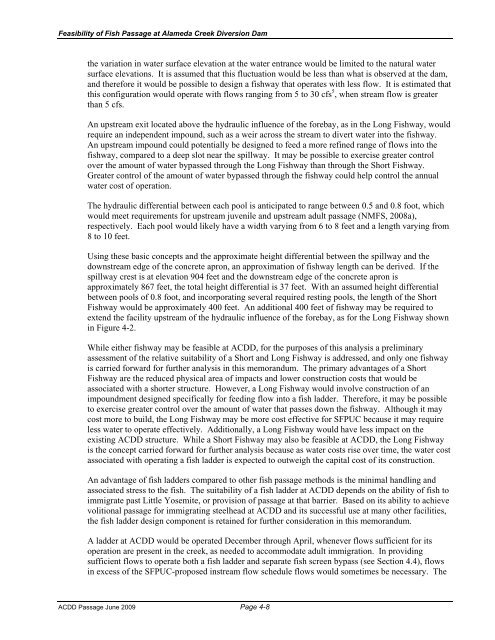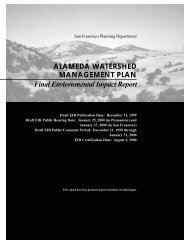Feasibility of Fish Passage at Alameda Creek Diversion Dam
Feasibility of Fish Passage at Alameda Creek Diversion Dam
Feasibility of Fish Passage at Alameda Creek Diversion Dam
Create successful ePaper yourself
Turn your PDF publications into a flip-book with our unique Google optimized e-Paper software.
<strong>Feasibility</strong> <strong>of</strong> <strong>Fish</strong> <strong>Passage</strong> <strong>at</strong> <strong>Alameda</strong> <strong>Creek</strong> <strong>Diversion</strong> <strong>Dam</strong>the vari<strong>at</strong>ion in w<strong>at</strong>er surface elev<strong>at</strong>ion <strong>at</strong> the w<strong>at</strong>er entrance would be limited to the n<strong>at</strong>ural w<strong>at</strong>ersurface elev<strong>at</strong>ions. It is assumed th<strong>at</strong> this fluctu<strong>at</strong>ion would be less than wh<strong>at</strong> is observed <strong>at</strong> the dam,and therefore it would be possible to design a fishway th<strong>at</strong> oper<strong>at</strong>es with less flow. It is estim<strong>at</strong>ed th<strong>at</strong>this configur<strong>at</strong>ion would oper<strong>at</strong>e with flows ranging from 5 to 30 cfs 5 , when stream flow is gre<strong>at</strong>erthan 5 cfs.An upstream exit loc<strong>at</strong>ed above the hydraulic influence <strong>of</strong> the forebay, as in the Long <strong>Fish</strong>way, wouldrequire an independent impound, such as a weir across the stream to divert w<strong>at</strong>er into the fishway.An upstream impound could potentially be designed to feed a more refined range <strong>of</strong> flows into thefishway, compared to a deep slot near the spillway. It may be possible to exercise gre<strong>at</strong>er controlover the amount <strong>of</strong> w<strong>at</strong>er bypassed through the Long <strong>Fish</strong>way than through the Short <strong>Fish</strong>way.Gre<strong>at</strong>er control <strong>of</strong> the amount <strong>of</strong> w<strong>at</strong>er bypassed through the fishway could help control the annualw<strong>at</strong>er cost <strong>of</strong> oper<strong>at</strong>ion.The hydraulic differential between each pool is anticip<strong>at</strong>ed to range between 0.5 and 0.8 foot, whichwould meet requirements for upstream juvenile and upstream adult passage (NMFS, 2008a),respectively. Each pool would likely have a width varying from 6 to 8 feet and a length varying from8 to 10 feet.Using these basic concepts and the approxim<strong>at</strong>e height differential between the spillway and thedownstream edge <strong>of</strong> the concrete apron, an approxim<strong>at</strong>ion <strong>of</strong> fishway length can be derived. If thespillway crest is <strong>at</strong> elev<strong>at</strong>ion 904 feet and the downstream edge <strong>of</strong> the concrete apron isapproxim<strong>at</strong>ely 867 feet, the total height differential is 37 feet. With an assumed height differentialbetween pools <strong>of</strong> 0.8 foot, and incorpor<strong>at</strong>ing several required resting pools, the length <strong>of</strong> the Short<strong>Fish</strong>way would be approxim<strong>at</strong>ely 400 feet. An additional 400 feet <strong>of</strong> fishway may be required toextend the facility upstream <strong>of</strong> the hydraulic influence <strong>of</strong> the forebay, as for the Long <strong>Fish</strong>way shownin Figure 4-2.While either fishway may be feasible <strong>at</strong> ACDD, for the purposes <strong>of</strong> this analysis a preliminaryassessment <strong>of</strong> the rel<strong>at</strong>ive suitability <strong>of</strong> a Short and Long <strong>Fish</strong>way is addressed, and only one fishwayis carried forward for further analysis in this memorandum. The primary advantages <strong>of</strong> a Short<strong>Fish</strong>way are the reduced physical area <strong>of</strong> impacts and lower construction costs th<strong>at</strong> would beassoci<strong>at</strong>ed with a shorter structure. However, a Long <strong>Fish</strong>way would involve construction <strong>of</strong> animpoundment designed specifically for feeding flow into a fish ladder. Therefore, it may be possibleto exercise gre<strong>at</strong>er control over the amount <strong>of</strong> w<strong>at</strong>er th<strong>at</strong> passes down the fishway. Although it maycost more to build, the Long <strong>Fish</strong>way may be more cost effective for SFPUC because it may requireless w<strong>at</strong>er to oper<strong>at</strong>e effectively. Additionally, a Long <strong>Fish</strong>way would have less impact on theexisting ACDD structure. While a Short <strong>Fish</strong>way may also be feasible <strong>at</strong> ACDD, the Long <strong>Fish</strong>wayis the concept carried forward for further analysis because as w<strong>at</strong>er costs rise over time, the w<strong>at</strong>er costassoci<strong>at</strong>ed with oper<strong>at</strong>ing a fish ladder is expected to outweigh the capital cost <strong>of</strong> its construction.An advantage <strong>of</strong> fish ladders compared to other fish passage methods is the minimal handling andassoci<strong>at</strong>ed stress to the fish. The suitability <strong>of</strong> a fish ladder <strong>at</strong> ACDD depends on the ability <strong>of</strong> fish toimmigr<strong>at</strong>e past Little Yosemite, or provision <strong>of</strong> passage <strong>at</strong> th<strong>at</strong> barrier. Based on its ability to achievevolitional passage for immigr<strong>at</strong>ing steelhead <strong>at</strong> ACDD and its successful use <strong>at</strong> many other facilities,the fish ladder design component is retained for further consider<strong>at</strong>ion in this memorandum.A ladder <strong>at</strong> ACDD would be oper<strong>at</strong>ed December through April, whenever flows sufficient for itsoper<strong>at</strong>ion are present in the creek, as needed to accommod<strong>at</strong>e adult immigr<strong>at</strong>ion. In providingsufficient flows to oper<strong>at</strong>e both a fish ladder and separ<strong>at</strong>e fish screen bypass (see Section 4.4), flowsin excess <strong>of</strong> the SFPUC-proposed instream flow schedule flows would sometimes be necessary. TheACDD <strong>Passage</strong> June 2009 Page 4-8








